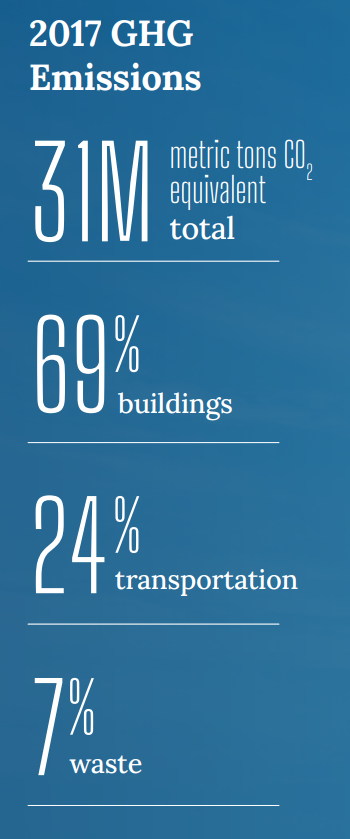Electrify Chicago
An independent tool for viewing City of Chicago building data
According to the
2022 Chicago Climate Action Plan,
69% of Chicago's emissions come from buildings, making
building emissions our biggest challenge and our biggest opportunity as a city
to tackle climate change. At Electrify Chicago, we showcase building performance using
publicly available data supplemented by community-submitted photographs and building
owners.
Start by looking at Chicago's buildings with the highest greenhouse gas intensity i.e. emissions per square foot. Large, efficient, buildings can perform much better than very inefficient small buildings on this metric.
New Article
📰 $30 Million In Missed Fines
The City Of Chicago failed to collect $30 million in potential fines from the building benchmarking ordinance, reducing transparency and accountability.
Legislative update! 🎉
As of late January 2024, legislation is being introduced to require new use more efficient forms of water and space heating, via the Clean And Affordable Buildings Ordinance (CABO), which will reduce the number of highly polluting and inefficient buildings that end up on this site.
If you're in Chicago,
write to your alderman to support the CABO!
Chicago Buildings by Greenhouse Gas Intensity
Note: Data includes large Chicago buildings with data from 2022, unless explicitly stated otherwise.
Note: This data only includes buildings whose emissions are reported
under the
Chicago Energy Benchmarking Ordinance. According to the City “As of 2016,
this list includes all commercial, institutional, and residential buildings larger than
50,000 square feet.” This dataset is also then filtered to only buildings with
reported emissions > 1,000 metric tons CO2 equivalent.
The latest year of data is from 2022, but we update the site regularly when new data is available, and some buildings may have failed to report that year, and only have older data available.
| Property Name / address | Primary Property Type |
Greenhouse Gas Intensity (kg CO2 eq./sqft) |
Total Greenhouse Emissions (metric tons CO2 eq.) |
|---|---|---|---|
|
Catholic Charities Ozanam Village
251 N Albany Avenue
| Multifamily Housing | 5.3 kg/sqft
Lowest 29%
| 266 tons
Lowest 6%
|
|
Marquette Elementary -CPS
(CPS)
6550 S Richmond St
| K-12 School | 5.3 kg/sqft
Lowest 29%
| 916 tons
Highest 48%
|
|
Moos Elementary -CPS
🕰️
(CPS)
1711 N California Ave
| K-12 School | 5.3 kg/sqft | 743 tons |
|
Chicago Military Academy-Bronzeville -CPS
(CPS)
3533 S Giles Ave
| K-12 School | 5.3 kg/sqft
Lowest 29%
| 643 tons
Lowest 37%
|
|
Gregory Elementary -CPS
🕰️
(CPS)
3707 W Polk
| K-12 School | 5.3 kg/sqft | 585 tons |
|
Bright, Orville T -CPS
🕰️
(CPS)
10740 S Calhoun Ave
| K-12 School | 5.3 kg/sqft | 481 tons |
|
Sayre Language Academy -CPS
(CPS)
1850 N Newland Ave
| K-12 School | 5.3 kg/sqft
Lowest 29%
| 424 tons
Lowest 19%
|
|
Jensen Scholastic Academy - CPS
🕰️
(CPS)
3024 W Harrison
| K-12 School | 5.3 kg/sqft | 338 tons |
|
Reside on Surf
425 W Surf St
| Multifamily Housing | 5.3 kg/sqft
Lowest 29%
| 633 tons
Lowest 36%
|
|
1120 N Lake Shore Dr
1120 N Lake Shore Dr
| Multifamily Housing | 5.3 kg/sqft
Lowest 29%
| 734 tons
Lowest 42%
|
|
Wilson Yard
1026 - 1032 W Montrose Ave
| Mixed Use Property | 5.3 kg/sqft
Lowest 29%
| 2,196 tons
Highest 21%
|
|
Maria Diaz Martinez Apts
(CHA)
2111 N Halsted St
| Multifamily Housing | 5.3 kg/sqft
Lowest 29%
| 656 tons
Lowest 37%
|
|
Judge Harry M. Fisher Apartments
(CHA)
5821 N Broadway St
| Multifamily Housing | 5.3 kg/sqft
Lowest 29%
| 916 tons
Highest 49%
|
|
Douglas Park
🕰️
1401 S Sacramento Dr
| Other - Recreation | 5.3 kg/sqft | 304 tons |
|
850 Dewitt Place Condominiums
850 N Dewitt Pl
| Multifamily Housing | 5.3 kg/sqft
Lowest 29%
| 1,407 tons
Highest 34%
|
Data Source:
Chicago Energy Benchmarking Data
